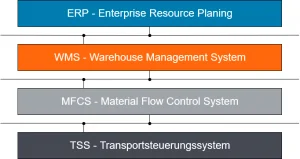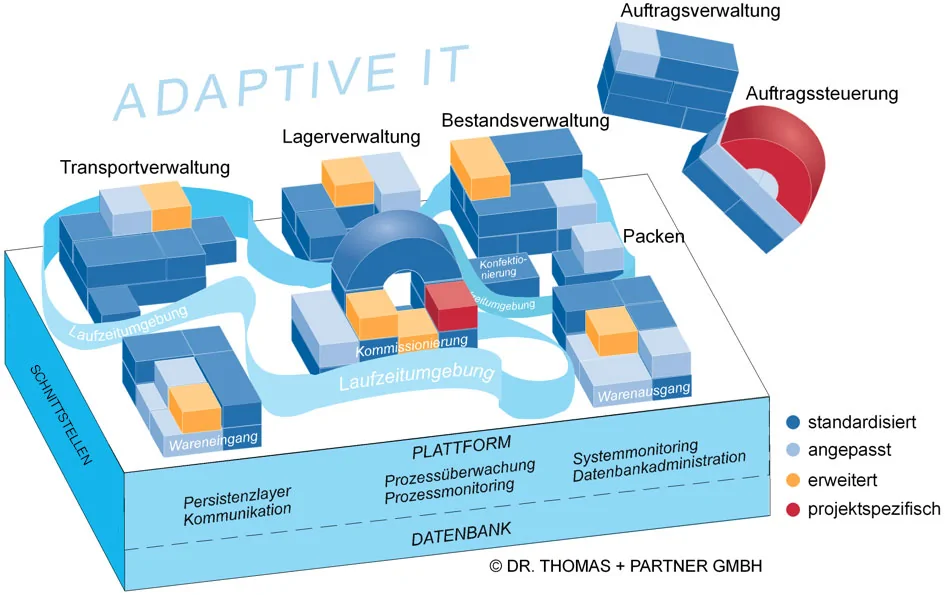Adaptive IT describes a modular system for modeling software. Individual software components can be added or removed as needed without affecting the existing system. This concept allows for a high degree of flexibility when planning a facility and also allows for further expansion in the medium and long term.
For this reason, careful consideration is given during the planning stage to determine which modules are really necessary in the first step to reliably solve the required tasks. Not all conceivable modules and features are useful and necessary at the beginning of a project.
Due to ignorance or misunderstood security considerations, a catalog of currently superfluous features is often ordered at the same time in order to have solutions ready for any eventualities or to rule out any subsequent acquisition costs. These are typical “belt and suspenders investments” that, in the worst case, permanently drain a company’s liquidity.
This planning problem is precisely where one of the compelling economic and technical arguments for adaptive IT comes into play: you only ever order the modules that are actually needed at the moment.

An intralogistics system never operates alone; it is always integrated into an IT environment.
Adaptive IT – Consideration of economic efficiency
In economic terms, adaptive IT means that a company can transfer the development of its business processes to its IT infrastructure in real time – without having to invest several steps ahead.
When a new process is added, the corresponding module is purchased and implemented. If a task or requirement is no longer necessary, the corresponding module is eliminated.
The latter measure, which may not seem necessary at first glance, quickly reveals its financial benefits upon closer inspection. With each computing operation that is eliminated, the hardware is relieved and maintenance costs are reduced. In large warehouse solutions, this can quickly lead to noticeable budget savings.
Adaptive IT – Technical advantages for the life cycle
From a technical point of view, a major advantage of adaptive software is that the various modules can be expanded, modernized, or replaced separately during their life cycles without causing any changes to the overall system.
In addition to the flexibility of the modules, a key factor in this adaptability is the consistent use of a central database. This database serves as the platform for every individual solution and ensures that information is always available immediately where it is needed.
Adaptive IT in the distribution center
Adaptive IT stands for a solution philosophy that involves creating many small program modules (= services) from a large program. These are assembled like modules, for example in a distribution center.
The actual platform consists of:
- the database
- the interfaces to the program modules
Applied to the processes of a distribution center, this means that the following processes generally occur between goods receipt and goods issue
- Storage
- Transport
- Order processing
as well as the interfaces to higher-level and lower-level systems.
Based on this knowledge, the recurring processes of each distribution center are designed to be as reusable and adaptable as possible.

Modular structure of adaptive IT in intralogistics.
However, in order for a customer-specific solution to succeed in a distribution center using reusable modules, the specific operational processes must also be understood in detail and taken into account.
Adaptive IT in the context of adaptive enterprises
The structure of adaptive IT enables a digital ecosystem to adapt quickly to new conditions and circumstances.
Example
Until now, the company was unable to accept rush orders or only did so in exceptional cases. However, due to increased customer demand, this service is to become an integral part of the service portfolio in the future. This first requires the appropriate strategic decision and subsequent operational implementation.
This is where adaptive IT comes into play, because in the age of Industry 4.0, an adaptive company or company culture – including in operational processes – is based on an IT platform. Adaptive elements enable new services to be implemented quickly and overall efficiency to be increased without having to completely change the IT landscape.
Summary
Adaptive IT in intralogistics describes the approach of implementing software in the form of a modular system (program modules/services) in a strategically, organizationally, and technologically differentiated manner. Using such modules, IT in a distribution center, for example, can be aligned in a specific, holistic, and pragmatic manner, with the individual modules being reusable.
For information on how productivity, maintainability, and ultimately software quality can be improved, see the article “The idea of modular software”.
